Strategic Management and Leadership Report: Khatib & Alami Case Study
VerifiedAdded on 2020/07/22
|19
|6476
|46
Report
AI Summary
This report provides a comprehensive analysis of strategic management and leadership, focusing on the case of Khatib & Alami, an engineering and architectural consulting firm. It delves into the analysis of political, social, ethical, and operational needs for common strategies between organizations and administrations. The report explores methodologies for developing collective strategies internally and externally, examining opportunities for future development to enhance impact on stakeholders. Key policy and strategy issues influencing collective strategy are defined, along with factors that affect it. It also addresses the resolution of tensions between organizational cultures and ethics, evaluating the use of strategic intelligence and knowledge in strategy formulation and development. The report further differentiates between individual aims and collective strategy aspirations, offering critical insights into various organizational, philosophical, and methodological approaches to strategic management.
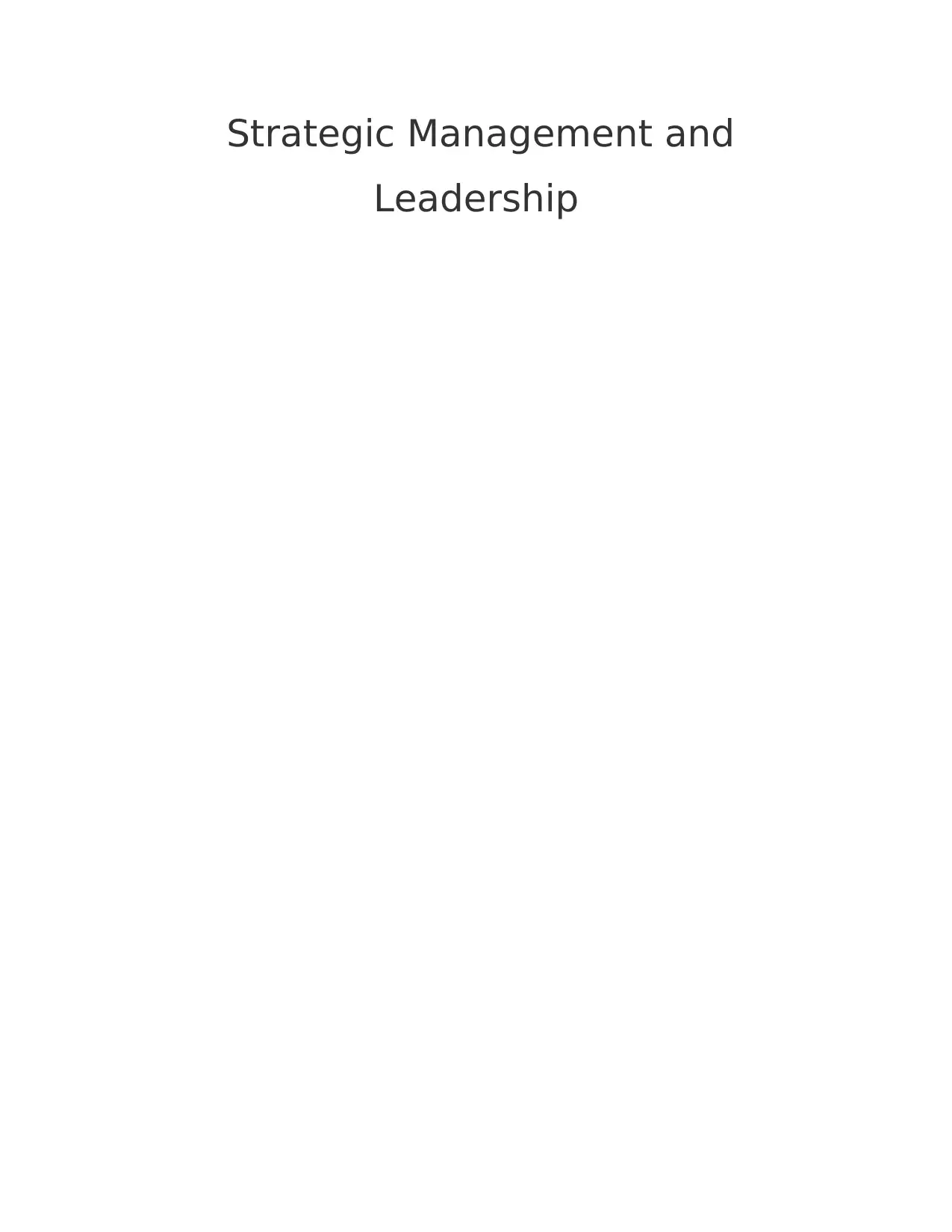
Strategic Management and
Leadership
Leadership
Paraphrase This Document
Need a fresh take? Get an instant paraphrase of this document with our AI Paraphraser
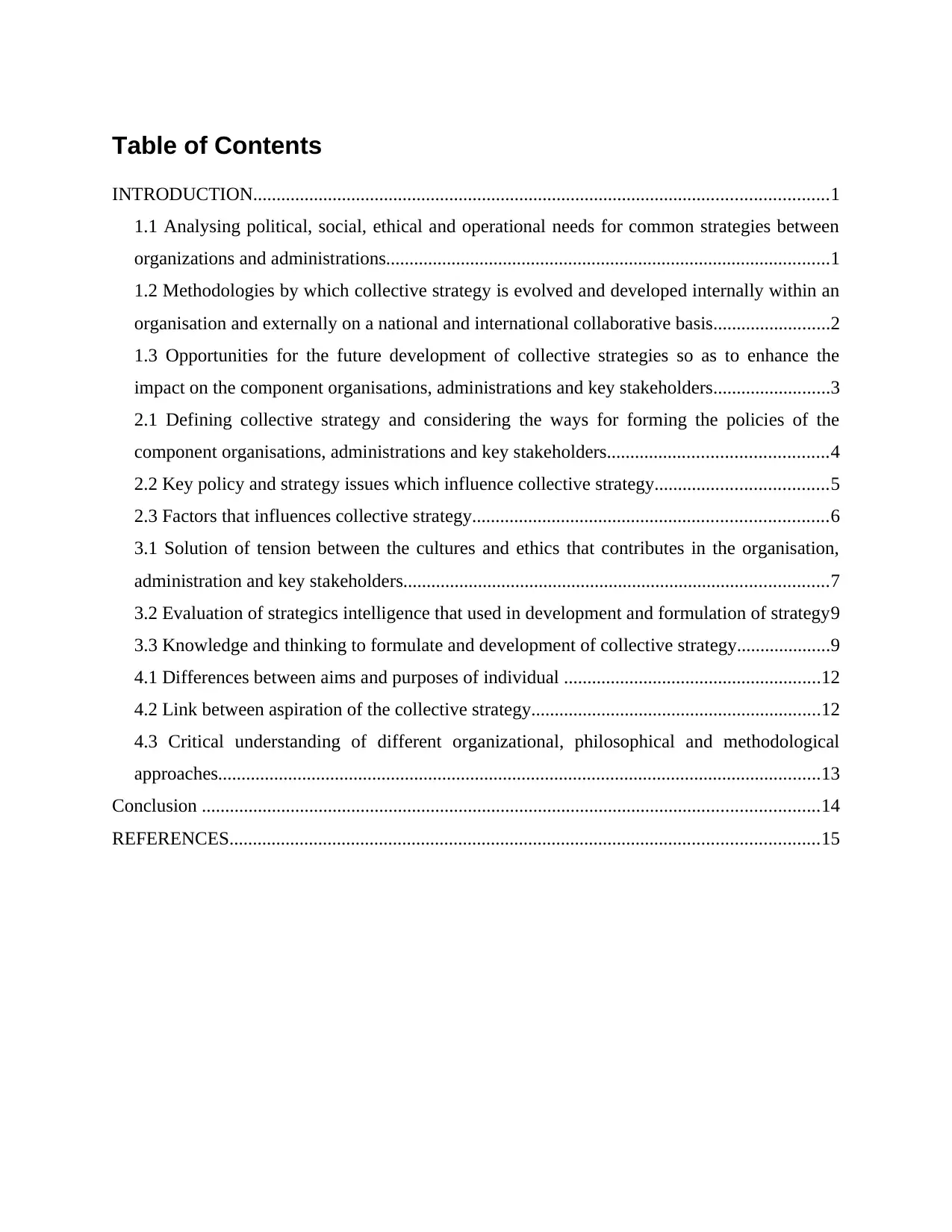
Table of Contents
INTRODUCTION...........................................................................................................................1
1.1 Analysing political, social, ethical and operational needs for common strategies between
organizations and administrations...............................................................................................1
1.2 Methodologies by which collective strategy is evolved and developed internally within an
organisation and externally on a national and international collaborative basis.........................2
1.3 Opportunities for the future development of collective strategies so as to enhance the
impact on the component organisations, administrations and key stakeholders.........................3
2.1 Defining collective strategy and considering the ways for forming the policies of the
component organisations, administrations and key stakeholders...............................................4
2.2 Key policy and strategy issues which influence collective strategy.....................................5
2.3 Factors that influences collective strategy............................................................................6
3.1 Solution of tension between the cultures and ethics that contributes in the organisation,
administration and key stakeholders...........................................................................................7
3.2 Evaluation of strategics intelligence that used in development and formulation of strategy9
3.3 Knowledge and thinking to formulate and development of collective strategy....................9
4.1 Differences between aims and purposes of individual .......................................................12
4.2 Link between aspiration of the collective strategy..............................................................12
4.3 Critical understanding of different organizational, philosophical and methodological
approaches.................................................................................................................................13
Conclusion ....................................................................................................................................14
REFERENCES..............................................................................................................................15
INTRODUCTION...........................................................................................................................1
1.1 Analysing political, social, ethical and operational needs for common strategies between
organizations and administrations...............................................................................................1
1.2 Methodologies by which collective strategy is evolved and developed internally within an
organisation and externally on a national and international collaborative basis.........................2
1.3 Opportunities for the future development of collective strategies so as to enhance the
impact on the component organisations, administrations and key stakeholders.........................3
2.1 Defining collective strategy and considering the ways for forming the policies of the
component organisations, administrations and key stakeholders...............................................4
2.2 Key policy and strategy issues which influence collective strategy.....................................5
2.3 Factors that influences collective strategy............................................................................6
3.1 Solution of tension between the cultures and ethics that contributes in the organisation,
administration and key stakeholders...........................................................................................7
3.2 Evaluation of strategics intelligence that used in development and formulation of strategy9
3.3 Knowledge and thinking to formulate and development of collective strategy....................9
4.1 Differences between aims and purposes of individual .......................................................12
4.2 Link between aspiration of the collective strategy..............................................................12
4.3 Critical understanding of different organizational, philosophical and methodological
approaches.................................................................................................................................13
Conclusion ....................................................................................................................................14
REFERENCES..............................................................................................................................15
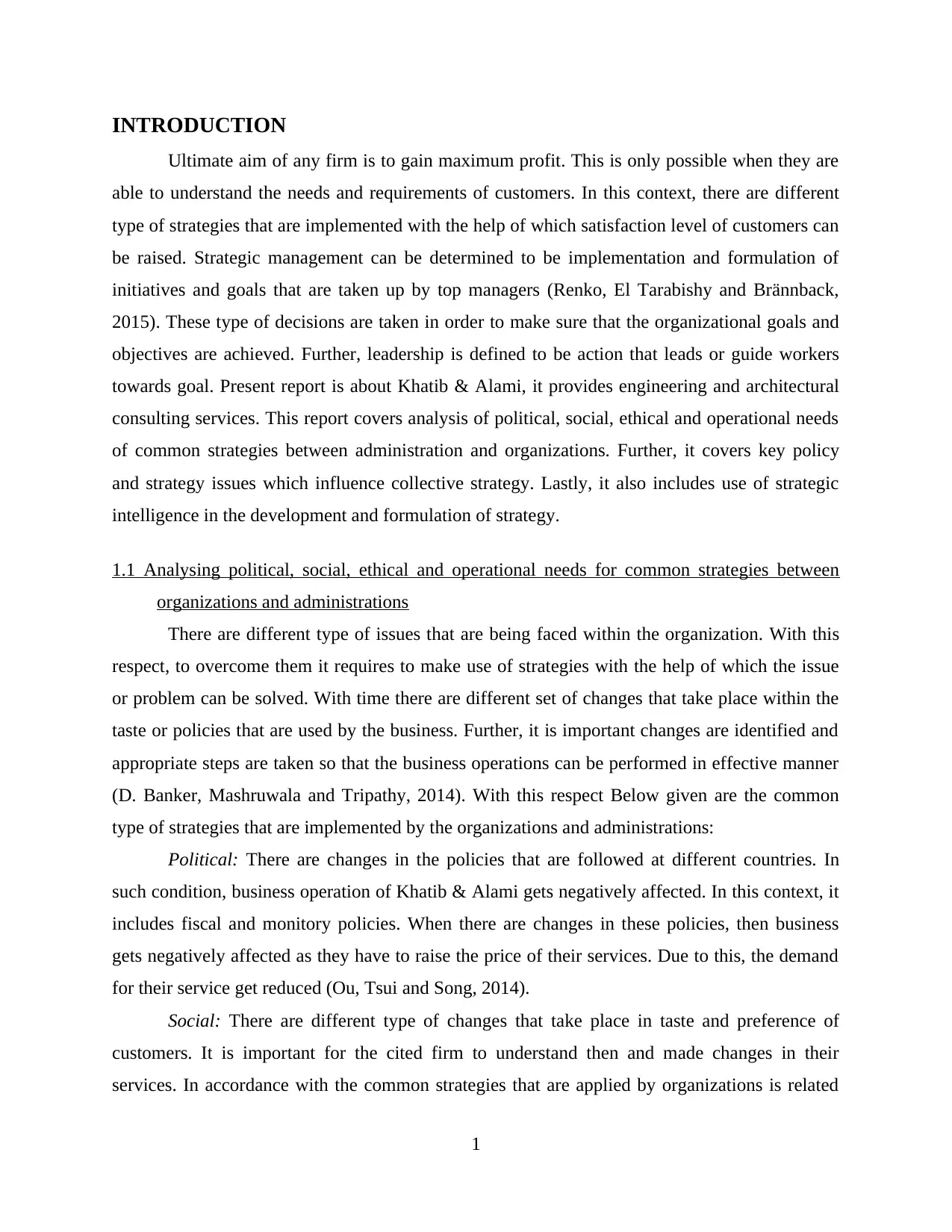
INTRODUCTION
Ultimate aim of any firm is to gain maximum profit. This is only possible when they are
able to understand the needs and requirements of customers. In this context, there are different
type of strategies that are implemented with the help of which satisfaction level of customers can
be raised. Strategic management can be determined to be implementation and formulation of
initiatives and goals that are taken up by top managers (Renko, El Tarabishy and Brännback,
2015). These type of decisions are taken in order to make sure that the organizational goals and
objectives are achieved. Further, leadership is defined to be action that leads or guide workers
towards goal. Present report is about Khatib & Alami, it provides engineering and architectural
consulting services. This report covers analysis of political, social, ethical and operational needs
of common strategies between administration and organizations. Further, it covers key policy
and strategy issues which influence collective strategy. Lastly, it also includes use of strategic
intelligence in the development and formulation of strategy.
1.1 Analysing political, social, ethical and operational needs for common strategies between
organizations and administrations
There are different type of issues that are being faced within the organization. With this
respect, to overcome them it requires to make use of strategies with the help of which the issue
or problem can be solved. With time there are different set of changes that take place within the
taste or policies that are used by the business. Further, it is important changes are identified and
appropriate steps are taken so that the business operations can be performed in effective manner
(D. Banker, Mashruwala and Tripathy, 2014). With this respect Below given are the common
type of strategies that are implemented by the organizations and administrations:
Political: There are changes in the policies that are followed at different countries. In
such condition, business operation of Khatib & Alami gets negatively affected. In this context, it
includes fiscal and monitory policies. When there are changes in these policies, then business
gets negatively affected as they have to raise the price of their services. Due to this, the demand
for their service get reduced (Ou, Tsui and Song, 2014).
Social: There are different type of changes that take place in taste and preference of
customers. It is important for the cited firm to understand then and made changes in their
services. In accordance with the common strategies that are applied by organizations is related
1
Ultimate aim of any firm is to gain maximum profit. This is only possible when they are
able to understand the needs and requirements of customers. In this context, there are different
type of strategies that are implemented with the help of which satisfaction level of customers can
be raised. Strategic management can be determined to be implementation and formulation of
initiatives and goals that are taken up by top managers (Renko, El Tarabishy and Brännback,
2015). These type of decisions are taken in order to make sure that the organizational goals and
objectives are achieved. Further, leadership is defined to be action that leads or guide workers
towards goal. Present report is about Khatib & Alami, it provides engineering and architectural
consulting services. This report covers analysis of political, social, ethical and operational needs
of common strategies between administration and organizations. Further, it covers key policy
and strategy issues which influence collective strategy. Lastly, it also includes use of strategic
intelligence in the development and formulation of strategy.
1.1 Analysing political, social, ethical and operational needs for common strategies between
organizations and administrations
There are different type of issues that are being faced within the organization. With this
respect, to overcome them it requires to make use of strategies with the help of which the issue
or problem can be solved. With time there are different set of changes that take place within the
taste or policies that are used by the business. Further, it is important changes are identified and
appropriate steps are taken so that the business operations can be performed in effective manner
(D. Banker, Mashruwala and Tripathy, 2014). With this respect Below given are the common
type of strategies that are implemented by the organizations and administrations:
Political: There are changes in the policies that are followed at different countries. In
such condition, business operation of Khatib & Alami gets negatively affected. In this context, it
includes fiscal and monitory policies. When there are changes in these policies, then business
gets negatively affected as they have to raise the price of their services. Due to this, the demand
for their service get reduced (Ou, Tsui and Song, 2014).
Social: There are different type of changes that take place in taste and preference of
customers. It is important for the cited firm to understand then and made changes in their
services. In accordance with the common strategies that are applied by organizations is related
1
⊘ This is a preview!⊘
Do you want full access?
Subscribe today to unlock all pages.

Trusted by 1+ million students worldwide
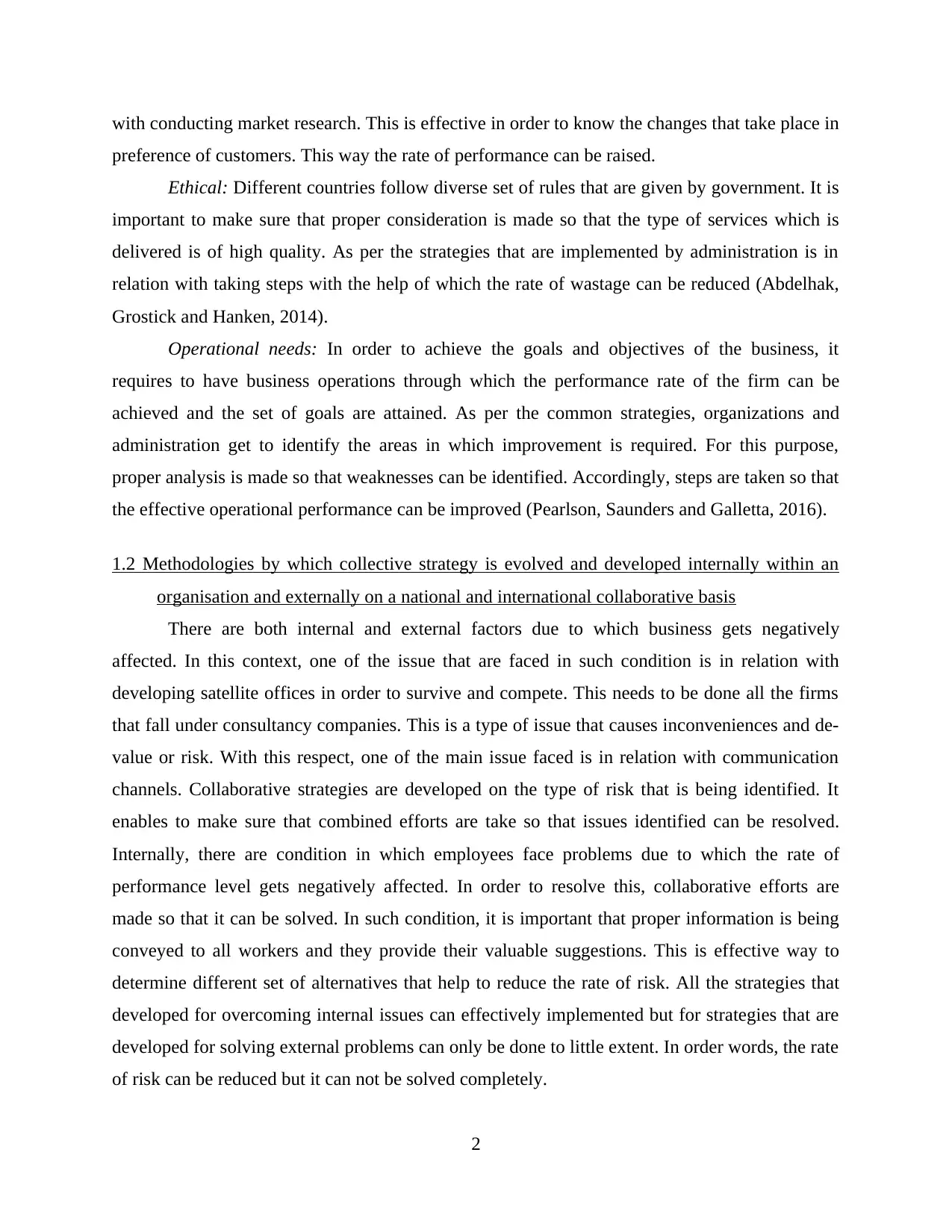
with conducting market research. This is effective in order to know the changes that take place in
preference of customers. This way the rate of performance can be raised.
Ethical: Different countries follow diverse set of rules that are given by government. It is
important to make sure that proper consideration is made so that the type of services which is
delivered is of high quality. As per the strategies that are implemented by administration is in
relation with taking steps with the help of which the rate of wastage can be reduced (Abdelhak,
Grostick and Hanken, 2014).
Operational needs: In order to achieve the goals and objectives of the business, it
requires to have business operations through which the performance rate of the firm can be
achieved and the set of goals are attained. As per the common strategies, organizations and
administration get to identify the areas in which improvement is required. For this purpose,
proper analysis is made so that weaknesses can be identified. Accordingly, steps are taken so that
the effective operational performance can be improved (Pearlson, Saunders and Galletta, 2016).
1.2 Methodologies by which collective strategy is evolved and developed internally within an
organisation and externally on a national and international collaborative basis
There are both internal and external factors due to which business gets negatively
affected. In this context, one of the issue that are faced in such condition is in relation with
developing satellite offices in order to survive and compete. This needs to be done all the firms
that fall under consultancy companies. This is a type of issue that causes inconveniences and de-
value or risk. With this respect, one of the main issue faced is in relation with communication
channels. Collaborative strategies are developed on the type of risk that is being identified. It
enables to make sure that combined efforts are take so that issues identified can be resolved.
Internally, there are condition in which employees face problems due to which the rate of
performance level gets negatively affected. In order to resolve this, collaborative efforts are
made so that it can be solved. In such condition, it is important that proper information is being
conveyed to all workers and they provide their valuable suggestions. This is effective way to
determine different set of alternatives that help to reduce the rate of risk. All the strategies that
developed for overcoming internal issues can effectively implemented but for strategies that are
developed for solving external problems can only be done to little extent. In order words, the rate
of risk can be reduced but it can not be solved completely.
2
preference of customers. This way the rate of performance can be raised.
Ethical: Different countries follow diverse set of rules that are given by government. It is
important to make sure that proper consideration is made so that the type of services which is
delivered is of high quality. As per the strategies that are implemented by administration is in
relation with taking steps with the help of which the rate of wastage can be reduced (Abdelhak,
Grostick and Hanken, 2014).
Operational needs: In order to achieve the goals and objectives of the business, it
requires to have business operations through which the performance rate of the firm can be
achieved and the set of goals are attained. As per the common strategies, organizations and
administration get to identify the areas in which improvement is required. For this purpose,
proper analysis is made so that weaknesses can be identified. Accordingly, steps are taken so that
the effective operational performance can be improved (Pearlson, Saunders and Galletta, 2016).
1.2 Methodologies by which collective strategy is evolved and developed internally within an
organisation and externally on a national and international collaborative basis
There are both internal and external factors due to which business gets negatively
affected. In this context, one of the issue that are faced in such condition is in relation with
developing satellite offices in order to survive and compete. This needs to be done all the firms
that fall under consultancy companies. This is a type of issue that causes inconveniences and de-
value or risk. With this respect, one of the main issue faced is in relation with communication
channels. Collaborative strategies are developed on the type of risk that is being identified. It
enables to make sure that combined efforts are take so that issues identified can be resolved.
Internally, there are condition in which employees face problems due to which the rate of
performance level gets negatively affected. In order to resolve this, collaborative efforts are
made so that it can be solved. In such condition, it is important that proper information is being
conveyed to all workers and they provide their valuable suggestions. This is effective way to
determine different set of alternatives that help to reduce the rate of risk. All the strategies that
developed for overcoming internal issues can effectively implemented but for strategies that are
developed for solving external problems can only be done to little extent. In order words, the rate
of risk can be reduced but it can not be solved completely.
2
Paraphrase This Document
Need a fresh take? Get an instant paraphrase of this document with our AI Paraphraser
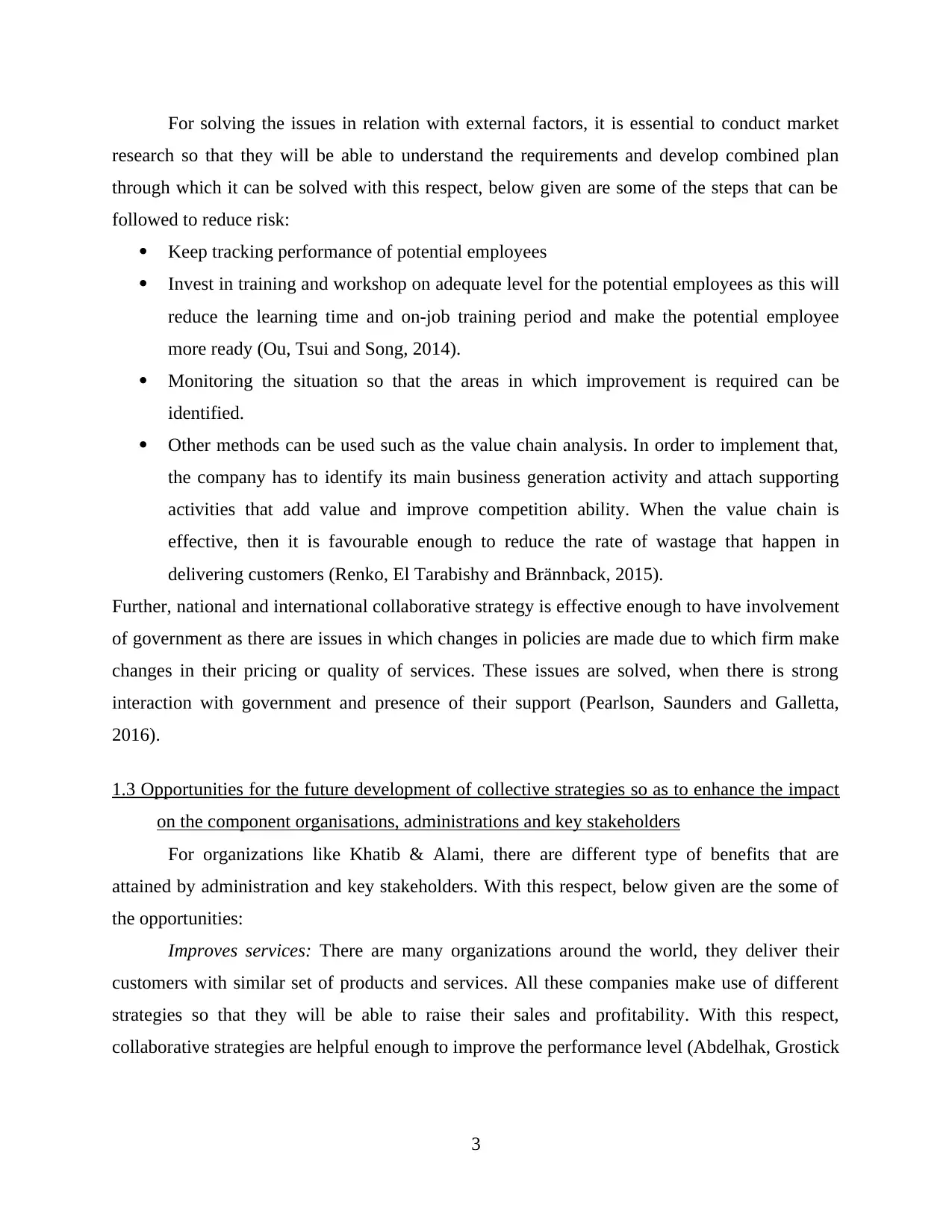
For solving the issues in relation with external factors, it is essential to conduct market
research so that they will be able to understand the requirements and develop combined plan
through which it can be solved with this respect, below given are some of the steps that can be
followed to reduce risk:
Keep tracking performance of potential employees
Invest in training and workshop on adequate level for the potential employees as this will
reduce the learning time and on-job training period and make the potential employee
more ready (Ou, Tsui and Song, 2014).
Monitoring the situation so that the areas in which improvement is required can be
identified.
Other methods can be used such as the value chain analysis. In order to implement that,
the company has to identify its main business generation activity and attach supporting
activities that add value and improve competition ability. When the value chain is
effective, then it is favourable enough to reduce the rate of wastage that happen in
delivering customers (Renko, El Tarabishy and Brännback, 2015).
Further, national and international collaborative strategy is effective enough to have involvement
of government as there are issues in which changes in policies are made due to which firm make
changes in their pricing or quality of services. These issues are solved, when there is strong
interaction with government and presence of their support (Pearlson, Saunders and Galletta,
2016).
1.3 Opportunities for the future development of collective strategies so as to enhance the impact
on the component organisations, administrations and key stakeholders
For organizations like Khatib & Alami, there are different type of benefits that are
attained by administration and key stakeholders. With this respect, below given are the some of
the opportunities:
Improves services: There are many organizations around the world, they deliver their
customers with similar set of products and services. All these companies make use of different
strategies so that they will be able to raise their sales and profitability. With this respect,
collaborative strategies are helpful enough to improve the performance level (Abdelhak, Grostick
3
research so that they will be able to understand the requirements and develop combined plan
through which it can be solved with this respect, below given are some of the steps that can be
followed to reduce risk:
Keep tracking performance of potential employees
Invest in training and workshop on adequate level for the potential employees as this will
reduce the learning time and on-job training period and make the potential employee
more ready (Ou, Tsui and Song, 2014).
Monitoring the situation so that the areas in which improvement is required can be
identified.
Other methods can be used such as the value chain analysis. In order to implement that,
the company has to identify its main business generation activity and attach supporting
activities that add value and improve competition ability. When the value chain is
effective, then it is favourable enough to reduce the rate of wastage that happen in
delivering customers (Renko, El Tarabishy and Brännback, 2015).
Further, national and international collaborative strategy is effective enough to have involvement
of government as there are issues in which changes in policies are made due to which firm make
changes in their pricing or quality of services. These issues are solved, when there is strong
interaction with government and presence of their support (Pearlson, Saunders and Galletta,
2016).
1.3 Opportunities for the future development of collective strategies so as to enhance the impact
on the component organisations, administrations and key stakeholders
For organizations like Khatib & Alami, there are different type of benefits that are
attained by administration and key stakeholders. With this respect, below given are the some of
the opportunities:
Improves services: There are many organizations around the world, they deliver their
customers with similar set of products and services. All these companies make use of different
strategies so that they will be able to raise their sales and profitability. With this respect,
collaborative strategies are helpful enough to improve the performance level (Abdelhak, Grostick
3
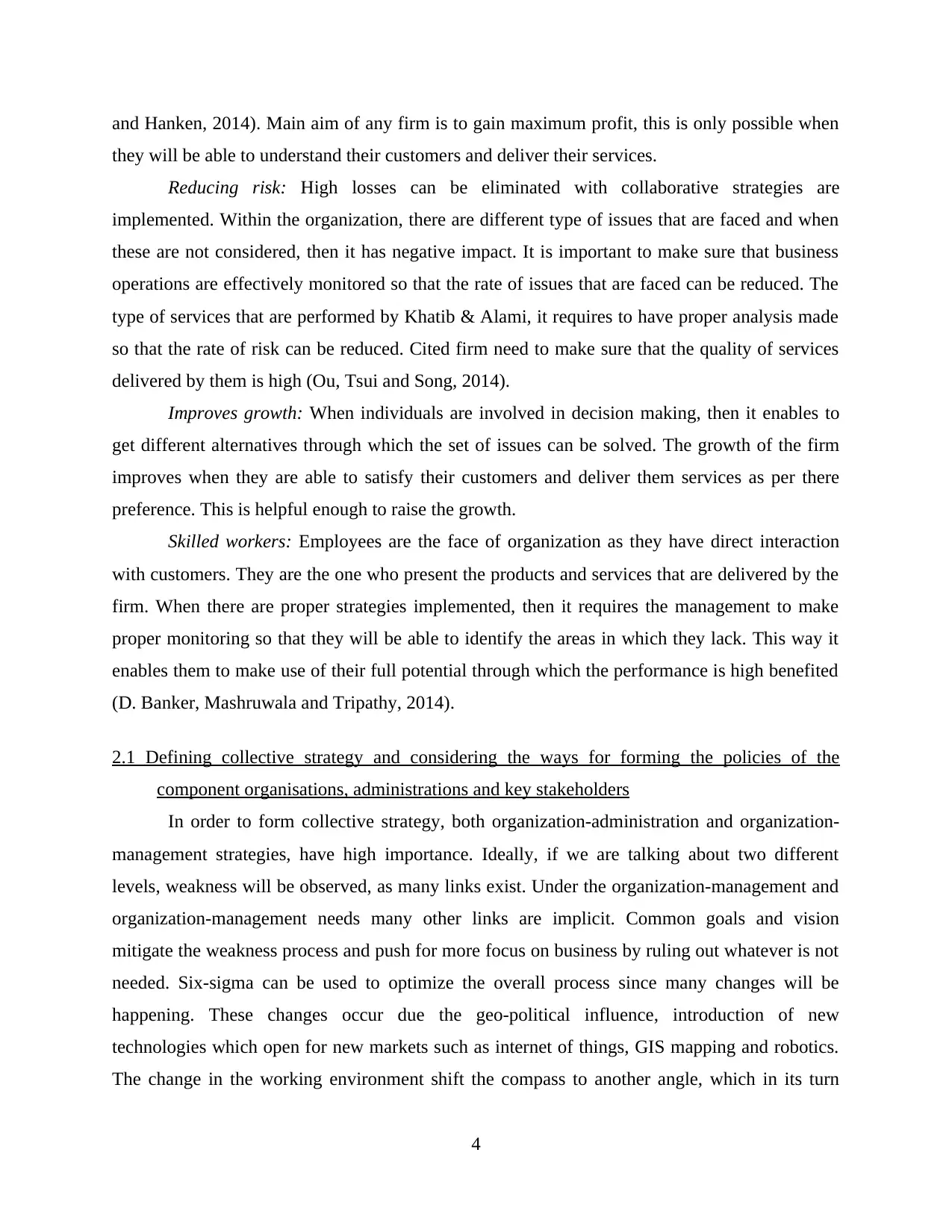
and Hanken, 2014). Main aim of any firm is to gain maximum profit, this is only possible when
they will be able to understand their customers and deliver their services.
Reducing risk: High losses can be eliminated with collaborative strategies are
implemented. Within the organization, there are different type of issues that are faced and when
these are not considered, then it has negative impact. It is important to make sure that business
operations are effectively monitored so that the rate of issues that are faced can be reduced. The
type of services that are performed by Khatib & Alami, it requires to have proper analysis made
so that the rate of risk can be reduced. Cited firm need to make sure that the quality of services
delivered by them is high (Ou, Tsui and Song, 2014).
Improves growth: When individuals are involved in decision making, then it enables to
get different alternatives through which the set of issues can be solved. The growth of the firm
improves when they are able to satisfy their customers and deliver them services as per there
preference. This is helpful enough to raise the growth.
Skilled workers: Employees are the face of organization as they have direct interaction
with customers. They are the one who present the products and services that are delivered by the
firm. When there are proper strategies implemented, then it requires the management to make
proper monitoring so that they will be able to identify the areas in which they lack. This way it
enables them to make use of their full potential through which the performance is high benefited
(D. Banker, Mashruwala and Tripathy, 2014).
2.1 Defining collective strategy and considering the ways for forming the policies of the
component organisations, administrations and key stakeholders
In order to form collective strategy, both organization-administration and organization-
management strategies, have high importance. Ideally, if we are talking about two different
levels, weakness will be observed, as many links exist. Under the organization-management and
organization-management needs many other links are implicit. Common goals and vision
mitigate the weakness process and push for more focus on business by ruling out whatever is not
needed. Six-sigma can be used to optimize the overall process since many changes will be
happening. These changes occur due the geo-political influence, introduction of new
technologies which open for new markets such as internet of things, GIS mapping and robotics.
The change in the working environment shift the compass to another angle, which in its turn
4
they will be able to understand their customers and deliver their services.
Reducing risk: High losses can be eliminated with collaborative strategies are
implemented. Within the organization, there are different type of issues that are faced and when
these are not considered, then it has negative impact. It is important to make sure that business
operations are effectively monitored so that the rate of issues that are faced can be reduced. The
type of services that are performed by Khatib & Alami, it requires to have proper analysis made
so that the rate of risk can be reduced. Cited firm need to make sure that the quality of services
delivered by them is high (Ou, Tsui and Song, 2014).
Improves growth: When individuals are involved in decision making, then it enables to
get different alternatives through which the set of issues can be solved. The growth of the firm
improves when they are able to satisfy their customers and deliver them services as per there
preference. This is helpful enough to raise the growth.
Skilled workers: Employees are the face of organization as they have direct interaction
with customers. They are the one who present the products and services that are delivered by the
firm. When there are proper strategies implemented, then it requires the management to make
proper monitoring so that they will be able to identify the areas in which they lack. This way it
enables them to make use of their full potential through which the performance is high benefited
(D. Banker, Mashruwala and Tripathy, 2014).
2.1 Defining collective strategy and considering the ways for forming the policies of the
component organisations, administrations and key stakeholders
In order to form collective strategy, both organization-administration and organization-
management strategies, have high importance. Ideally, if we are talking about two different
levels, weakness will be observed, as many links exist. Under the organization-management and
organization-management needs many other links are implicit. Common goals and vision
mitigate the weakness process and push for more focus on business by ruling out whatever is not
needed. Six-sigma can be used to optimize the overall process since many changes will be
happening. These changes occur due the geo-political influence, introduction of new
technologies which open for new markets such as internet of things, GIS mapping and robotics.
The change in the working environment shift the compass to another angle, which in its turn
4
⊘ This is a preview!⊘
Do you want full access?
Subscribe today to unlock all pages.

Trusted by 1+ million students worldwide
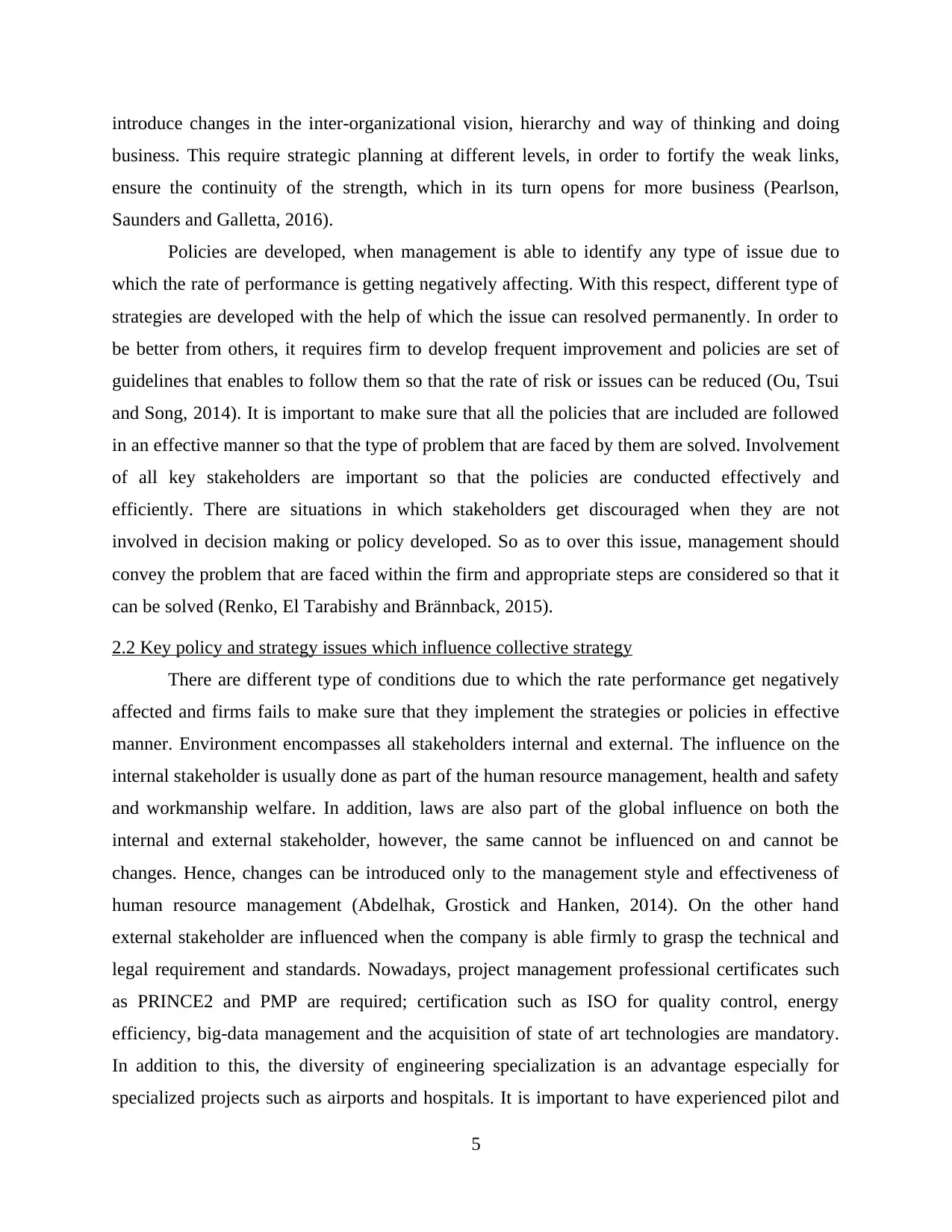
introduce changes in the inter-organizational vision, hierarchy and way of thinking and doing
business. This require strategic planning at different levels, in order to fortify the weak links,
ensure the continuity of the strength, which in its turn opens for more business (Pearlson,
Saunders and Galletta, 2016).
Policies are developed, when management is able to identify any type of issue due to
which the rate of performance is getting negatively affecting. With this respect, different type of
strategies are developed with the help of which the issue can resolved permanently. In order to
be better from others, it requires firm to develop frequent improvement and policies are set of
guidelines that enables to follow them so that the rate of risk or issues can be reduced (Ou, Tsui
and Song, 2014). It is important to make sure that all the policies that are included are followed
in an effective manner so that the type of problem that are faced by them are solved. Involvement
of all key stakeholders are important so that the policies are conducted effectively and
efficiently. There are situations in which stakeholders get discouraged when they are not
involved in decision making or policy developed. So as to over this issue, management should
convey the problem that are faced within the firm and appropriate steps are considered so that it
can be solved (Renko, El Tarabishy and Brännback, 2015).
2.2 Key policy and strategy issues which influence collective strategy
There are different type of conditions due to which the rate performance get negatively
affected and firms fails to make sure that they implement the strategies or policies in effective
manner. Environment encompasses all stakeholders internal and external. The influence on the
internal stakeholder is usually done as part of the human resource management, health and safety
and workmanship welfare. In addition, laws are also part of the global influence on both the
internal and external stakeholder, however, the same cannot be influenced on and cannot be
changes. Hence, changes can be introduced only to the management style and effectiveness of
human resource management (Abdelhak, Grostick and Hanken, 2014). On the other hand
external stakeholder are influenced when the company is able firmly to grasp the technical and
legal requirement and standards. Nowadays, project management professional certificates such
as PRINCE2 and PMP are required; certification such as ISO for quality control, energy
efficiency, big-data management and the acquisition of state of art technologies are mandatory.
In addition to this, the diversity of engineering specialization is an advantage especially for
specialized projects such as airports and hospitals. It is important to have experienced pilot and
5
business. This require strategic planning at different levels, in order to fortify the weak links,
ensure the continuity of the strength, which in its turn opens for more business (Pearlson,
Saunders and Galletta, 2016).
Policies are developed, when management is able to identify any type of issue due to
which the rate of performance is getting negatively affecting. With this respect, different type of
strategies are developed with the help of which the issue can resolved permanently. In order to
be better from others, it requires firm to develop frequent improvement and policies are set of
guidelines that enables to follow them so that the rate of risk or issues can be reduced (Ou, Tsui
and Song, 2014). It is important to make sure that all the policies that are included are followed
in an effective manner so that the type of problem that are faced by them are solved. Involvement
of all key stakeholders are important so that the policies are conducted effectively and
efficiently. There are situations in which stakeholders get discouraged when they are not
involved in decision making or policy developed. So as to over this issue, management should
convey the problem that are faced within the firm and appropriate steps are considered so that it
can be solved (Renko, El Tarabishy and Brännback, 2015).
2.2 Key policy and strategy issues which influence collective strategy
There are different type of conditions due to which the rate performance get negatively
affected and firms fails to make sure that they implement the strategies or policies in effective
manner. Environment encompasses all stakeholders internal and external. The influence on the
internal stakeholder is usually done as part of the human resource management, health and safety
and workmanship welfare. In addition, laws are also part of the global influence on both the
internal and external stakeholder, however, the same cannot be influenced on and cannot be
changes. Hence, changes can be introduced only to the management style and effectiveness of
human resource management (Abdelhak, Grostick and Hanken, 2014). On the other hand
external stakeholder are influenced when the company is able firmly to grasp the technical and
legal requirement and standards. Nowadays, project management professional certificates such
as PRINCE2 and PMP are required; certification such as ISO for quality control, energy
efficiency, big-data management and the acquisition of state of art technologies are mandatory.
In addition to this, the diversity of engineering specialization is an advantage especially for
specialized projects such as airports and hospitals. It is important to have experienced pilot and
5
Paraphrase This Document
Need a fresh take? Get an instant paraphrase of this document with our AI Paraphraser
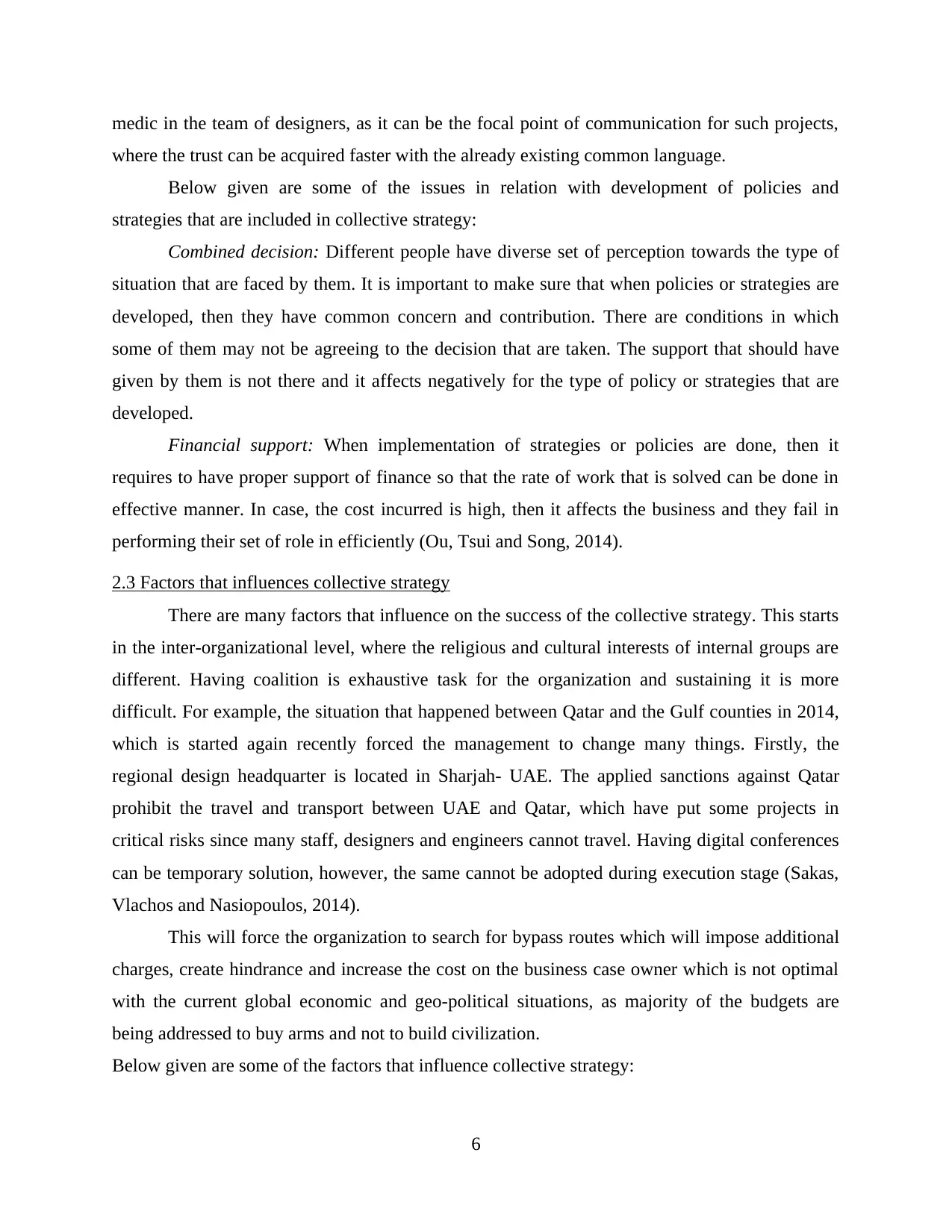
medic in the team of designers, as it can be the focal point of communication for such projects,
where the trust can be acquired faster with the already existing common language.
Below given are some of the issues in relation with development of policies and
strategies that are included in collective strategy:
Combined decision: Different people have diverse set of perception towards the type of
situation that are faced by them. It is important to make sure that when policies or strategies are
developed, then they have common concern and contribution. There are conditions in which
some of them may not be agreeing to the decision that are taken. The support that should have
given by them is not there and it affects negatively for the type of policy or strategies that are
developed.
Financial support: When implementation of strategies or policies are done, then it
requires to have proper support of finance so that the rate of work that is solved can be done in
effective manner. In case, the cost incurred is high, then it affects the business and they fail in
performing their set of role in efficiently (Ou, Tsui and Song, 2014).
2.3 Factors that influences collective strategy
There are many factors that influence on the success of the collective strategy. This starts
in the inter-organizational level, where the religious and cultural interests of internal groups are
different. Having coalition is exhaustive task for the organization and sustaining it is more
difficult. For example, the situation that happened between Qatar and the Gulf counties in 2014,
which is started again recently forced the management to change many things. Firstly, the
regional design headquarter is located in Sharjah- UAE. The applied sanctions against Qatar
prohibit the travel and transport between UAE and Qatar, which have put some projects in
critical risks since many staff, designers and engineers cannot travel. Having digital conferences
can be temporary solution, however, the same cannot be adopted during execution stage (Sakas,
Vlachos and Nasiopoulos, 2014).
This will force the organization to search for bypass routes which will impose additional
charges, create hindrance and increase the cost on the business case owner which is not optimal
with the current global economic and geo-political situations, as majority of the budgets are
being addressed to buy arms and not to build civilization.
Below given are some of the factors that influence collective strategy:
6
where the trust can be acquired faster with the already existing common language.
Below given are some of the issues in relation with development of policies and
strategies that are included in collective strategy:
Combined decision: Different people have diverse set of perception towards the type of
situation that are faced by them. It is important to make sure that when policies or strategies are
developed, then they have common concern and contribution. There are conditions in which
some of them may not be agreeing to the decision that are taken. The support that should have
given by them is not there and it affects negatively for the type of policy or strategies that are
developed.
Financial support: When implementation of strategies or policies are done, then it
requires to have proper support of finance so that the rate of work that is solved can be done in
effective manner. In case, the cost incurred is high, then it affects the business and they fail in
performing their set of role in efficiently (Ou, Tsui and Song, 2014).
2.3 Factors that influences collective strategy
There are many factors that influence on the success of the collective strategy. This starts
in the inter-organizational level, where the religious and cultural interests of internal groups are
different. Having coalition is exhaustive task for the organization and sustaining it is more
difficult. For example, the situation that happened between Qatar and the Gulf counties in 2014,
which is started again recently forced the management to change many things. Firstly, the
regional design headquarter is located in Sharjah- UAE. The applied sanctions against Qatar
prohibit the travel and transport between UAE and Qatar, which have put some projects in
critical risks since many staff, designers and engineers cannot travel. Having digital conferences
can be temporary solution, however, the same cannot be adopted during execution stage (Sakas,
Vlachos and Nasiopoulos, 2014).
This will force the organization to search for bypass routes which will impose additional
charges, create hindrance and increase the cost on the business case owner which is not optimal
with the current global economic and geo-political situations, as majority of the budgets are
being addressed to buy arms and not to build civilization.
Below given are some of the factors that influence collective strategy:
6
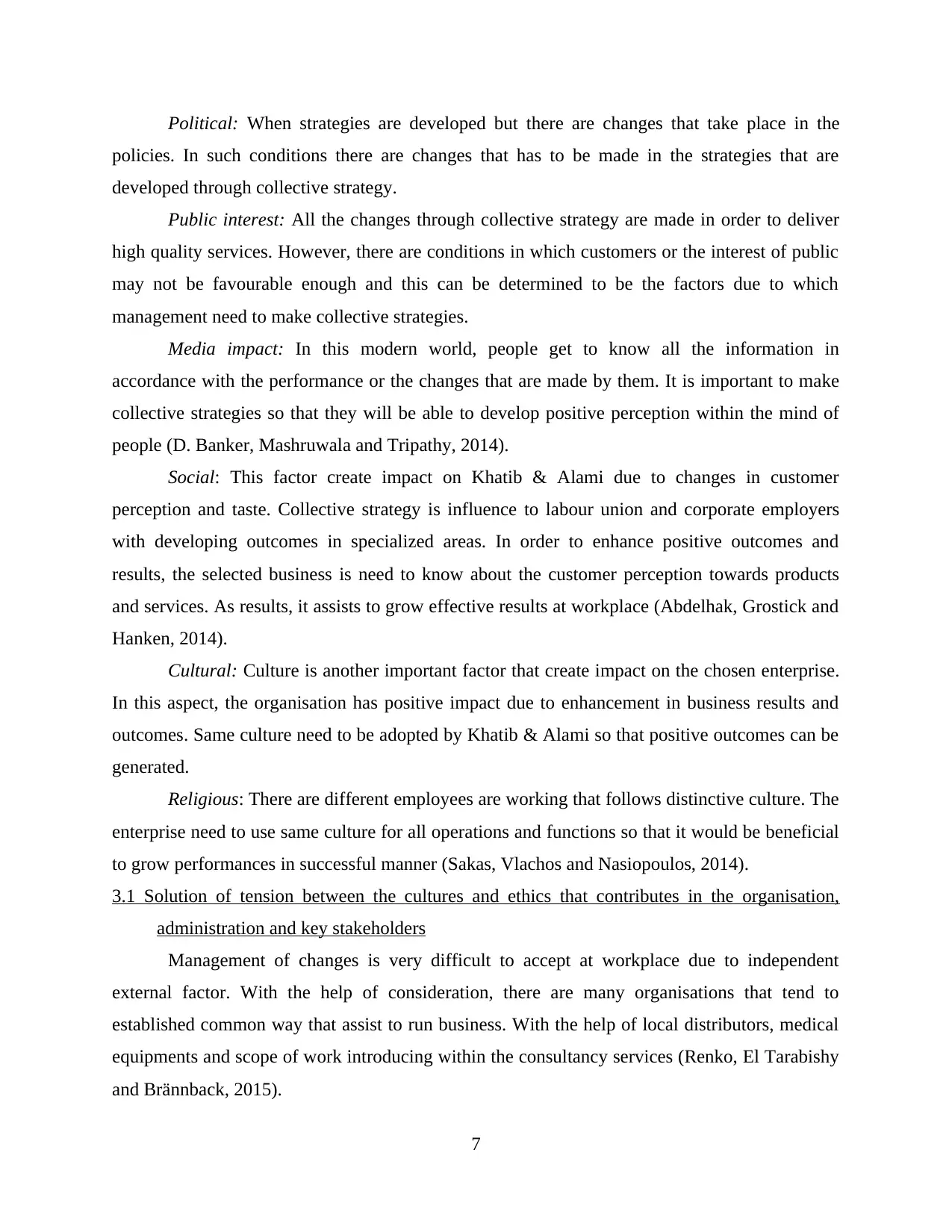
Political: When strategies are developed but there are changes that take place in the
policies. In such conditions there are changes that has to be made in the strategies that are
developed through collective strategy.
Public interest: All the changes through collective strategy are made in order to deliver
high quality services. However, there are conditions in which customers or the interest of public
may not be favourable enough and this can be determined to be the factors due to which
management need to make collective strategies.
Media impact: In this modern world, people get to know all the information in
accordance with the performance or the changes that are made by them. It is important to make
collective strategies so that they will be able to develop positive perception within the mind of
people (D. Banker, Mashruwala and Tripathy, 2014).
Social: This factor create impact on Khatib & Alami due to changes in customer
perception and taste. Collective strategy is influence to labour union and corporate employers
with developing outcomes in specialized areas. In order to enhance positive outcomes and
results, the selected business is need to know about the customer perception towards products
and services. As results, it assists to grow effective results at workplace (Abdelhak, Grostick and
Hanken, 2014).
Cultural: Culture is another important factor that create impact on the chosen enterprise.
In this aspect, the organisation has positive impact due to enhancement in business results and
outcomes. Same culture need to be adopted by Khatib & Alami so that positive outcomes can be
generated.
Religious: There are different employees are working that follows distinctive culture. The
enterprise need to use same culture for all operations and functions so that it would be beneficial
to grow performances in successful manner (Sakas, Vlachos and Nasiopoulos, 2014).
3.1 Solution of tension between the cultures and ethics that contributes in the organisation,
administration and key stakeholders
Management of changes is very difficult to accept at workplace due to independent
external factor. With the help of consideration, there are many organisations that tend to
established common way that assist to run business. With the help of local distributors, medical
equipments and scope of work introducing within the consultancy services (Renko, El Tarabishy
and Brännback, 2015).
7
policies. In such conditions there are changes that has to be made in the strategies that are
developed through collective strategy.
Public interest: All the changes through collective strategy are made in order to deliver
high quality services. However, there are conditions in which customers or the interest of public
may not be favourable enough and this can be determined to be the factors due to which
management need to make collective strategies.
Media impact: In this modern world, people get to know all the information in
accordance with the performance or the changes that are made by them. It is important to make
collective strategies so that they will be able to develop positive perception within the mind of
people (D. Banker, Mashruwala and Tripathy, 2014).
Social: This factor create impact on Khatib & Alami due to changes in customer
perception and taste. Collective strategy is influence to labour union and corporate employers
with developing outcomes in specialized areas. In order to enhance positive outcomes and
results, the selected business is need to know about the customer perception towards products
and services. As results, it assists to grow effective results at workplace (Abdelhak, Grostick and
Hanken, 2014).
Cultural: Culture is another important factor that create impact on the chosen enterprise.
In this aspect, the organisation has positive impact due to enhancement in business results and
outcomes. Same culture need to be adopted by Khatib & Alami so that positive outcomes can be
generated.
Religious: There are different employees are working that follows distinctive culture. The
enterprise need to use same culture for all operations and functions so that it would be beneficial
to grow performances in successful manner (Sakas, Vlachos and Nasiopoulos, 2014).
3.1 Solution of tension between the cultures and ethics that contributes in the organisation,
administration and key stakeholders
Management of changes is very difficult to accept at workplace due to independent
external factor. With the help of consideration, there are many organisations that tend to
established common way that assist to run business. With the help of local distributors, medical
equipments and scope of work introducing within the consultancy services (Renko, El Tarabishy
and Brännback, 2015).
7
⊘ This is a preview!⊘
Do you want full access?
Subscribe today to unlock all pages.

Trusted by 1+ million students worldwide
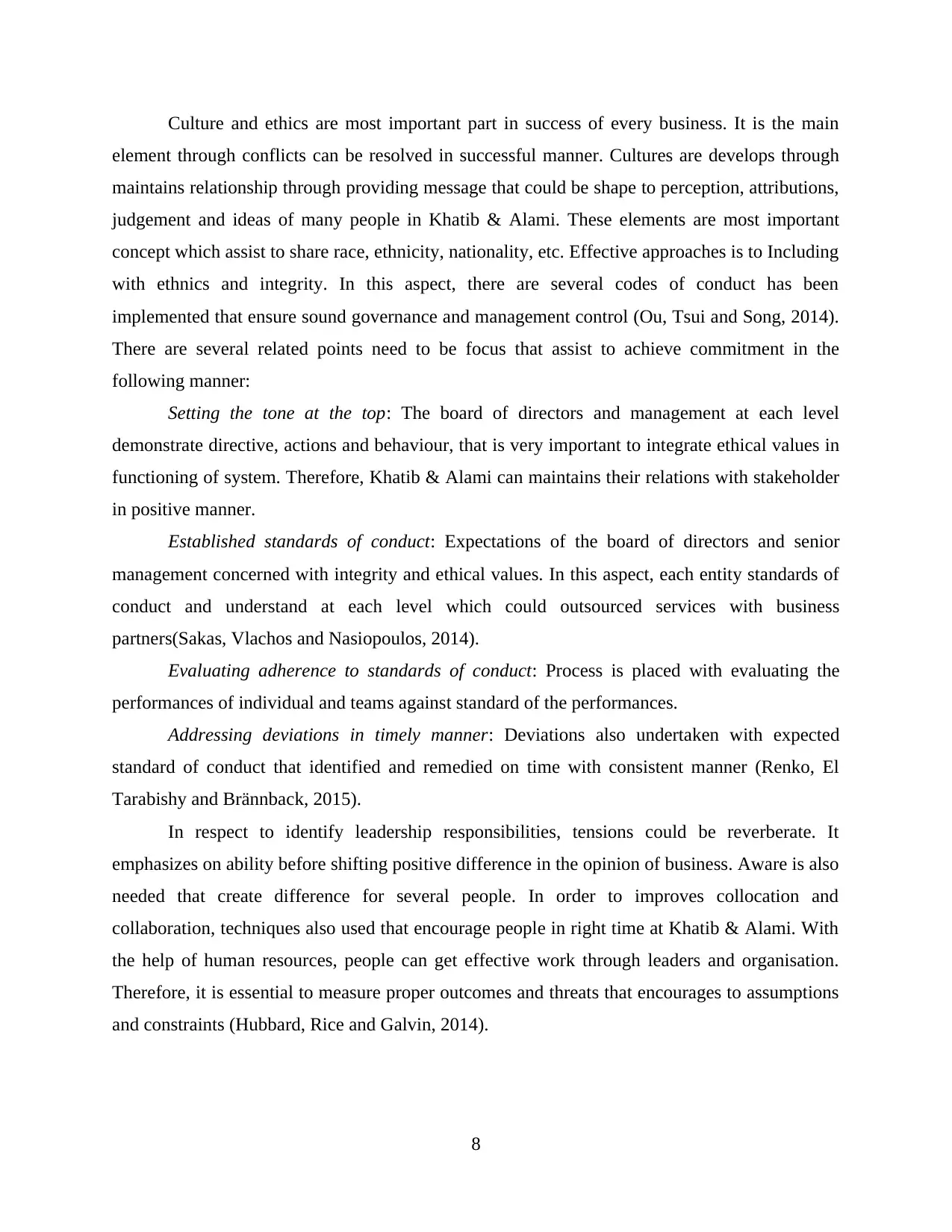
Culture and ethics are most important part in success of every business. It is the main
element through conflicts can be resolved in successful manner. Cultures are develops through
maintains relationship through providing message that could be shape to perception, attributions,
judgement and ideas of many people in Khatib & Alami. These elements are most important
concept which assist to share race, ethnicity, nationality, etc. Effective approaches is to Including
with ethnics and integrity. In this aspect, there are several codes of conduct has been
implemented that ensure sound governance and management control (Ou, Tsui and Song, 2014).
There are several related points need to be focus that assist to achieve commitment in the
following manner:
Setting the tone at the top: The board of directors and management at each level
demonstrate directive, actions and behaviour, that is very important to integrate ethical values in
functioning of system. Therefore, Khatib & Alami can maintains their relations with stakeholder
in positive manner.
Established standards of conduct: Expectations of the board of directors and senior
management concerned with integrity and ethical values. In this aspect, each entity standards of
conduct and understand at each level which could outsourced services with business
partners(Sakas, Vlachos and Nasiopoulos, 2014).
Evaluating adherence to standards of conduct: Process is placed with evaluating the
performances of individual and teams against standard of the performances.
Addressing deviations in timely manner: Deviations also undertaken with expected
standard of conduct that identified and remedied on time with consistent manner (Renko, El
Tarabishy and Brännback, 2015).
In respect to identify leadership responsibilities, tensions could be reverberate. It
emphasizes on ability before shifting positive difference in the opinion of business. Aware is also
needed that create difference for several people. In order to improves collocation and
collaboration, techniques also used that encourage people in right time at Khatib & Alami. With
the help of human resources, people can get effective work through leaders and organisation.
Therefore, it is essential to measure proper outcomes and threats that encourages to assumptions
and constraints (Hubbard, Rice and Galvin, 2014).
8
element through conflicts can be resolved in successful manner. Cultures are develops through
maintains relationship through providing message that could be shape to perception, attributions,
judgement and ideas of many people in Khatib & Alami. These elements are most important
concept which assist to share race, ethnicity, nationality, etc. Effective approaches is to Including
with ethnics and integrity. In this aspect, there are several codes of conduct has been
implemented that ensure sound governance and management control (Ou, Tsui and Song, 2014).
There are several related points need to be focus that assist to achieve commitment in the
following manner:
Setting the tone at the top: The board of directors and management at each level
demonstrate directive, actions and behaviour, that is very important to integrate ethical values in
functioning of system. Therefore, Khatib & Alami can maintains their relations with stakeholder
in positive manner.
Established standards of conduct: Expectations of the board of directors and senior
management concerned with integrity and ethical values. In this aspect, each entity standards of
conduct and understand at each level which could outsourced services with business
partners(Sakas, Vlachos and Nasiopoulos, 2014).
Evaluating adherence to standards of conduct: Process is placed with evaluating the
performances of individual and teams against standard of the performances.
Addressing deviations in timely manner: Deviations also undertaken with expected
standard of conduct that identified and remedied on time with consistent manner (Renko, El
Tarabishy and Brännback, 2015).
In respect to identify leadership responsibilities, tensions could be reverberate. It
emphasizes on ability before shifting positive difference in the opinion of business. Aware is also
needed that create difference for several people. In order to improves collocation and
collaboration, techniques also used that encourage people in right time at Khatib & Alami. With
the help of human resources, people can get effective work through leaders and organisation.
Therefore, it is essential to measure proper outcomes and threats that encourages to assumptions
and constraints (Hubbard, Rice and Galvin, 2014).
8
Paraphrase This Document
Need a fresh take? Get an instant paraphrase of this document with our AI Paraphraser
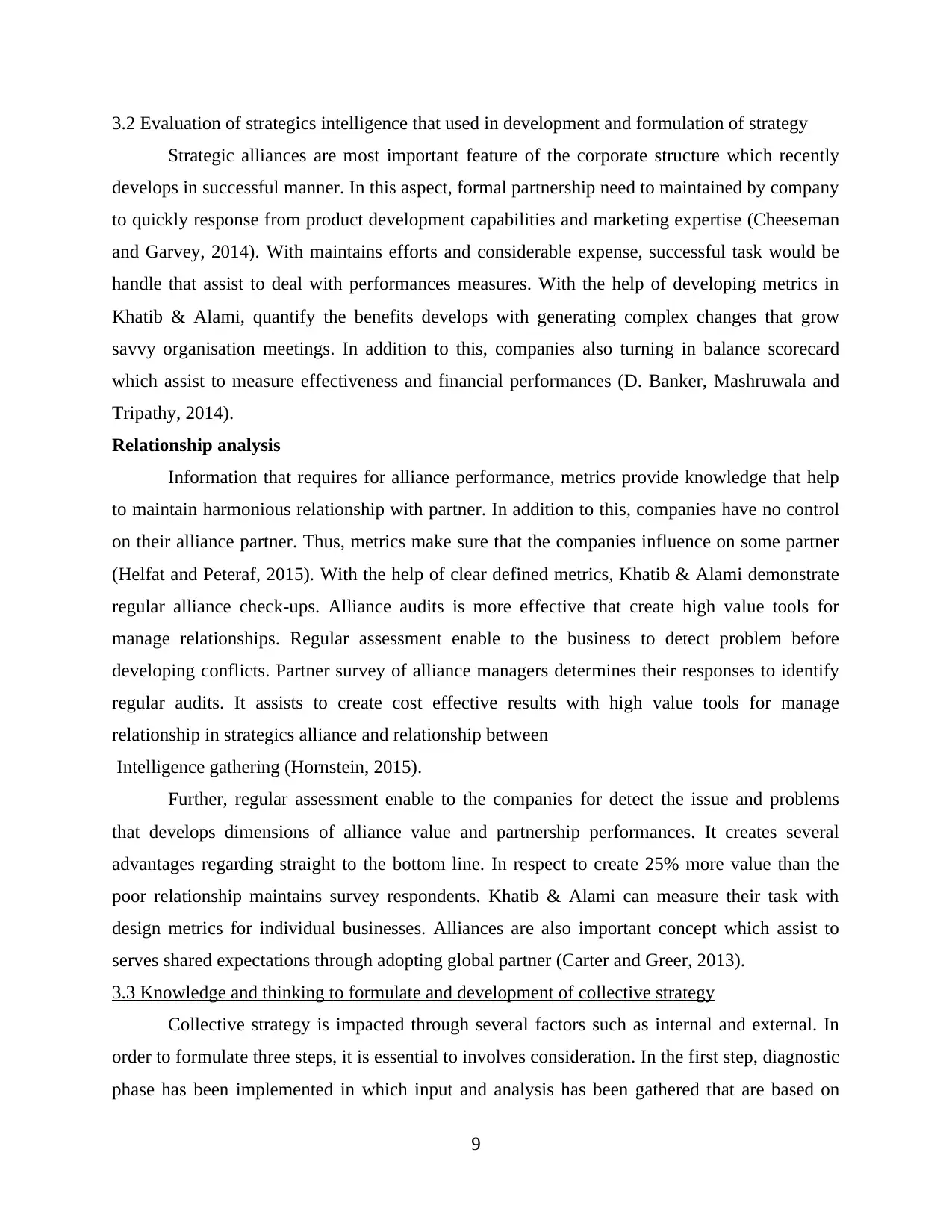
3.2 Evaluation of strategics intelligence that used in development and formulation of strategy
Strategic alliances are most important feature of the corporate structure which recently
develops in successful manner. In this aspect, formal partnership need to maintained by company
to quickly response from product development capabilities and marketing expertise (Cheeseman
and Garvey, 2014). With maintains efforts and considerable expense, successful task would be
handle that assist to deal with performances measures. With the help of developing metrics in
Khatib & Alami, quantify the benefits develops with generating complex changes that grow
savvy organisation meetings. In addition to this, companies also turning in balance scorecard
which assist to measure effectiveness and financial performances (D. Banker, Mashruwala and
Tripathy, 2014).
Relationship analysis
Information that requires for alliance performance, metrics provide knowledge that help
to maintain harmonious relationship with partner. In addition to this, companies have no control
on their alliance partner. Thus, metrics make sure that the companies influence on some partner
(Helfat and Peteraf, 2015). With the help of clear defined metrics, Khatib & Alami demonstrate
regular alliance check-ups. Alliance audits is more effective that create high value tools for
manage relationships. Regular assessment enable to the business to detect problem before
developing conflicts. Partner survey of alliance managers determines their responses to identify
regular audits. It assists to create cost effective results with high value tools for manage
relationship in strategics alliance and relationship between
Intelligence gathering (Hornstein, 2015).
Further, regular assessment enable to the companies for detect the issue and problems
that develops dimensions of alliance value and partnership performances. It creates several
advantages regarding straight to the bottom line. In respect to create 25% more value than the
poor relationship maintains survey respondents. Khatib & Alami can measure their task with
design metrics for individual businesses. Alliances are also important concept which assist to
serves shared expectations through adopting global partner (Carter and Greer, 2013).
3.3 Knowledge and thinking to formulate and development of collective strategy
Collective strategy is impacted through several factors such as internal and external. In
order to formulate three steps, it is essential to involves consideration. In the first step, diagnostic
phase has been implemented in which input and analysis has been gathered that are based on
9
Strategic alliances are most important feature of the corporate structure which recently
develops in successful manner. In this aspect, formal partnership need to maintained by company
to quickly response from product development capabilities and marketing expertise (Cheeseman
and Garvey, 2014). With maintains efforts and considerable expense, successful task would be
handle that assist to deal with performances measures. With the help of developing metrics in
Khatib & Alami, quantify the benefits develops with generating complex changes that grow
savvy organisation meetings. In addition to this, companies also turning in balance scorecard
which assist to measure effectiveness and financial performances (D. Banker, Mashruwala and
Tripathy, 2014).
Relationship analysis
Information that requires for alliance performance, metrics provide knowledge that help
to maintain harmonious relationship with partner. In addition to this, companies have no control
on their alliance partner. Thus, metrics make sure that the companies influence on some partner
(Helfat and Peteraf, 2015). With the help of clear defined metrics, Khatib & Alami demonstrate
regular alliance check-ups. Alliance audits is more effective that create high value tools for
manage relationships. Regular assessment enable to the business to detect problem before
developing conflicts. Partner survey of alliance managers determines their responses to identify
regular audits. It assists to create cost effective results with high value tools for manage
relationship in strategics alliance and relationship between
Intelligence gathering (Hornstein, 2015).
Further, regular assessment enable to the companies for detect the issue and problems
that develops dimensions of alliance value and partnership performances. It creates several
advantages regarding straight to the bottom line. In respect to create 25% more value than the
poor relationship maintains survey respondents. Khatib & Alami can measure their task with
design metrics for individual businesses. Alliances are also important concept which assist to
serves shared expectations through adopting global partner (Carter and Greer, 2013).
3.3 Knowledge and thinking to formulate and development of collective strategy
Collective strategy is impacted through several factors such as internal and external. In
order to formulate three steps, it is essential to involves consideration. In the first step, diagnostic
phase has been implemented in which input and analysis has been gathered that are based on
9
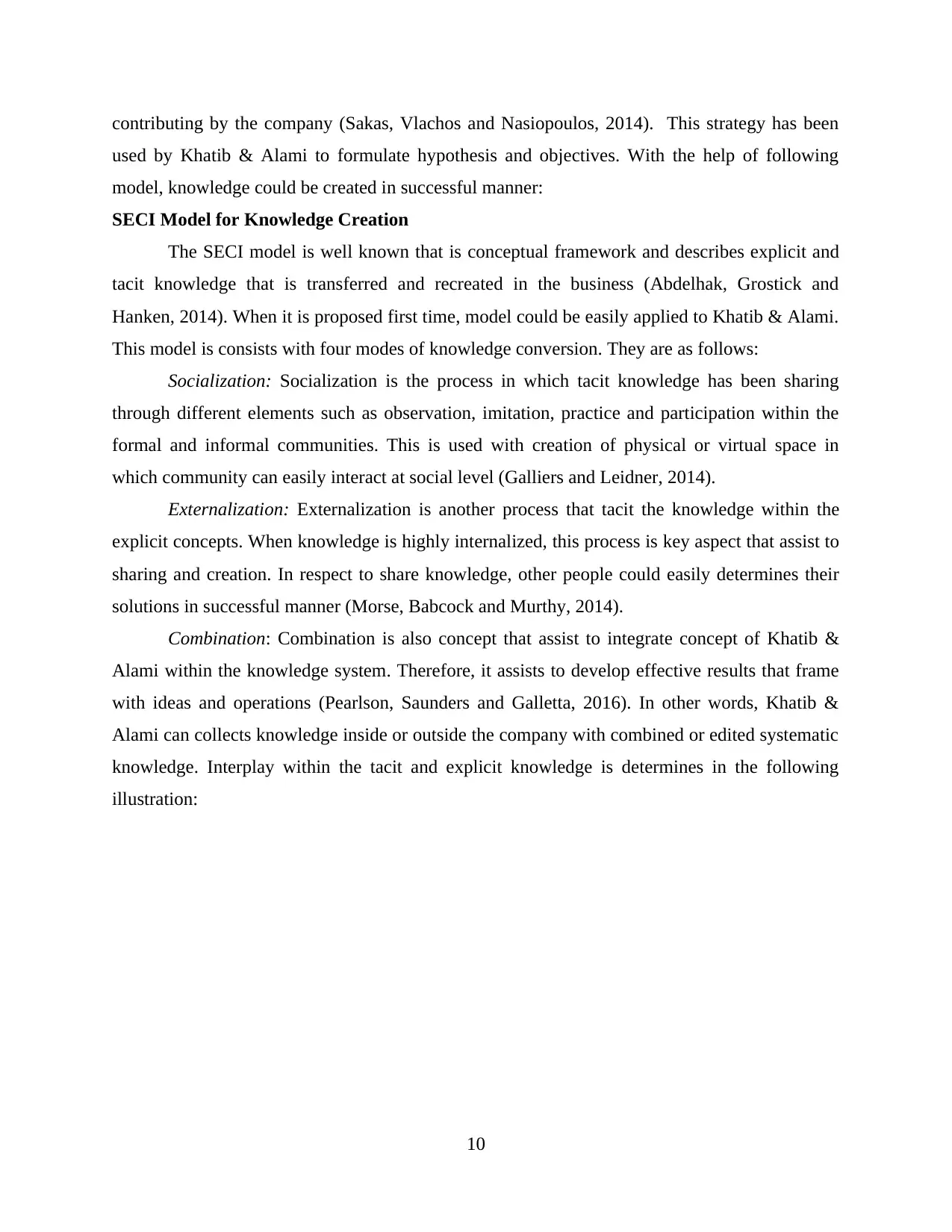
contributing by the company (Sakas, Vlachos and Nasiopoulos, 2014). This strategy has been
used by Khatib & Alami to formulate hypothesis and objectives. With the help of following
model, knowledge could be created in successful manner:
SECI Model for Knowledge Creation
The SECI model is well known that is conceptual framework and describes explicit and
tacit knowledge that is transferred and recreated in the business (Abdelhak, Grostick and
Hanken, 2014). When it is proposed first time, model could be easily applied to Khatib & Alami.
This model is consists with four modes of knowledge conversion. They are as follows:
Socialization: Socialization is the process in which tacit knowledge has been sharing
through different elements such as observation, imitation, practice and participation within the
formal and informal communities. This is used with creation of physical or virtual space in
which community can easily interact at social level (Galliers and Leidner, 2014).
Externalization: Externalization is another process that tacit the knowledge within the
explicit concepts. When knowledge is highly internalized, this process is key aspect that assist to
sharing and creation. In respect to share knowledge, other people could easily determines their
solutions in successful manner (Morse, Babcock and Murthy, 2014).
Combination: Combination is also concept that assist to integrate concept of Khatib &
Alami within the knowledge system. Therefore, it assists to develop effective results that frame
with ideas and operations (Pearlson, Saunders and Galletta, 2016). In other words, Khatib &
Alami can collects knowledge inside or outside the company with combined or edited systematic
knowledge. Interplay within the tacit and explicit knowledge is determines in the following
illustration:
10
used by Khatib & Alami to formulate hypothesis and objectives. With the help of following
model, knowledge could be created in successful manner:
SECI Model for Knowledge Creation
The SECI model is well known that is conceptual framework and describes explicit and
tacit knowledge that is transferred and recreated in the business (Abdelhak, Grostick and
Hanken, 2014). When it is proposed first time, model could be easily applied to Khatib & Alami.
This model is consists with four modes of knowledge conversion. They are as follows:
Socialization: Socialization is the process in which tacit knowledge has been sharing
through different elements such as observation, imitation, practice and participation within the
formal and informal communities. This is used with creation of physical or virtual space in
which community can easily interact at social level (Galliers and Leidner, 2014).
Externalization: Externalization is another process that tacit the knowledge within the
explicit concepts. When knowledge is highly internalized, this process is key aspect that assist to
sharing and creation. In respect to share knowledge, other people could easily determines their
solutions in successful manner (Morse, Babcock and Murthy, 2014).
Combination: Combination is also concept that assist to integrate concept of Khatib &
Alami within the knowledge system. Therefore, it assists to develop effective results that frame
with ideas and operations (Pearlson, Saunders and Galletta, 2016). In other words, Khatib &
Alami can collects knowledge inside or outside the company with combined or edited systematic
knowledge. Interplay within the tacit and explicit knowledge is determines in the following
illustration:
10
⊘ This is a preview!⊘
Do you want full access?
Subscribe today to unlock all pages.

Trusted by 1+ million students worldwide
1 out of 19
Related Documents
Your All-in-One AI-Powered Toolkit for Academic Success.
+13062052269
info@desklib.com
Available 24*7 on WhatsApp / Email
![[object Object]](/_next/static/media/star-bottom.7253800d.svg)
Unlock your academic potential
Copyright © 2020–2025 A2Z Services. All Rights Reserved. Developed and managed by ZUCOL.





